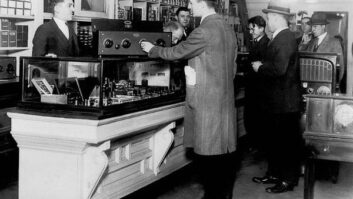I recently got a chance to work on a station for the Tlingit Tribe in Yakutat, Alaska. The station is being launched by Gloria Benson, who works in social services and community health for the tribe.

Audio inputs where there is no Internet: Here’s a studio featuring karaoke and boombox.
The studio is in a building that once housed the town’s school, but is now the courthouse and planning department. Yakutat has roughly 780 residents. Most of the economy is based around commercial fishing. There are no roads to Yakutat from anywhere — the only way in is by airplane or via ferry during the summer. It is located about 30 miles from a gigantic glacier. The town first received cell phone service only three years ago, and my phone did not even work there. I was happy to have a break from answering it!
Prior to our project, the town only had one radio station on the dial: KCAW(FM), a repeater of Raven Radio on K211BY. KCAW is quite good, but it has no content locally produced in Yakutat.
A major goal for the station is to help with the preservation of the Tlingit language. After generations of suppression by the government, native languages are now being recognized for their importance, and some attempts are being made to revive them. The station has been doing interviews with Tlingit elders, who recount histories of big events in the town, such as the 1964 tsunami. The station broadcasts mostly in English, but they are starting to record short announcements in Tlingit to help people retain basic vocabulary.
Yakutat is an extremely self-reliant town — which is what you would expect from a place with a lot of bears hanging out at the local garbage dump. People are accustomed to being far from outside help. The unfortunate flip side to this is that it can be hard to get on the map when you need to be.
Gray Haertig, who did the allocation work for the license, discovered that the one major tower in town had never been registered. The Coast Guard, owner of the tower in this remote spot, could not complete the proper registration paperwork for over a year.
At first glance, I thought that it would be good to apply for a 100-watt LPFM, rather than the Class D 10 watts. However, the whole population of Yakutat lives within a few miles and there is only one other station on the dial, so in truth, the 10-watt coverage is fine.
Our budget was not high enough for new studio equipment, so we made a simple but functional studio with hand-me-downs. In the photo above, you may notice a karaoke player and a boombox being used to play CDs and cassettes. The playlist also runs on a free software program known as ZaraRadio, which is good for basic automation.
OFF-LINE, ON-AIR
The station cannot yet afford an Internet connection. Internet service is very hard to come by in Yakutat. There is just one supplier, which provides the service via satellite. The dish is about $1,000 and the service is an additional $80 to $200 per month. The data limits are also quite draconian. If you download more than your quota in any seven-day period, your Internet is turned off until the beginning of the next seven-day period.
This was a challenge for the station, which was constructed in a municipal building that also housed the courthouse and planning department. They refused to share Internet with the station because kids had recently gotten into the building and watched a few videos on YouTube, which resulted in the city government’s Internet being shut off for the rest of the week!
Consequently, most of the content on the station consists of locally produced shows, some downloaded podcasts and a random mix of music. The station also broadcasts city council meetings live by calling in from a speakerphone and patching it on to the air at the studio. Basketball games are phoned in live via cell phone from neighboring towns. They recently had some very successful programming from the yearly Tern Festival that featured interviews with biologists in town who study the nearby bird population.
THE POTLATCH TRADITION
During my time on site, I was invited to attend a potlatch ceremony, which is one of the most notable aspects of Tlingit culture. A potlatch is a ceremony during which the Tlingit extravagantly give away their possessions. While in the lower 48 we have an image of subsistence living in the Arctic as a very hard and austere life, the Tlingit were wealthy compared to other indigenous cultures. There was an enormous surplus of food and animal products harvested from the bountiful oceans nearby — so much so that the wealthier Tlingit routinely redistributed wealth and some even destroyed surplus possessions during potlatch feasts.
Western Christian missionaries considered the practice heretical and irrational, and in order to instill Christian and capitalist values, they succeeded in outlawing the ritual. The Tlingit continued the potlatch tradition covertly under the guise of funerals. Even though they are no longer illegal, potlatches have retained their association with funerals. The potlatch that I attended was held in honor of several elders who had recently passed, including a prominent storyteller and keeper of the tribe’s language and traditions.
Some observers believe that a social function of the potlatch is to help redistribute the wealth, so that the gap between the rich and the poor does not get too big and destabilize society. In light of Oxfam’s recent report (http://tinyurl.com/nny2nth), which concluded that 1 percent of the world population will have more than half of the world’s wealth by 2016, some might say that the Tlingit potlatch practices may be more intelligent and decent than the ones of those who sought to “civilize” the tribe.
While at times there has been some federal support for native radio, the Yakutat station has not been able to find any funding of that kind at this point. Most of the funds for the start-up were raised locally from festivals or came from agencies that promote health initiatives.
I learned a lesson or two about Alaska while I was there. One day, I had to climb the tower to install a studio transmitter link dish. My backup climber and I scheduled the installation for 1 p.m. By the early afternoon, I got to work stringing cable and installing the dish. After a while, I looked up at the sky and saw that the sun was just inches above the horizon. I had no way of telling time, and I panicked, wondering how long had I been up there.
The sun looked like it would be going down in minutes, and I did not have a flashlight with me. I was nervous that there would be potential storms the next day and that my work would blow away, so I decided to continue working just a little more to get things as closed up as possible. Soon, I was engrossed with my work and continued on for another hour. I remembered my concern and looked back up at the sun — it was in the same place! I had completely forgotten that while a few inches above the horizon means “You’ve got 15 minutes, get off the tower” down in the lower 48, in Alaska things are different. The sun never gets more than a few inches above the horizon, and it would not get dark for another few hours. My intuitions about time were all wrong.
I asked station founder Gloria Benson if there was one thing that could magically appear to improve the station, she could not keep her answer confined to one thing. She replied, “Enough money for a station manager and an Internet connection.”
Benson has been eating into her allowable bandwidth at home just to download the occasional podcast and bring them into the station on a thumb drive. In a town of 780, there is only so much local content to produce and many people do not have Internet access to connect with events in the outside world. She would like to be able to download more shows from native public media and other sources, but it’s not possible, yet.
Pete Tridish is a radio engineer and community radio policy advocate with the non-profit station building group, International Media Action.












